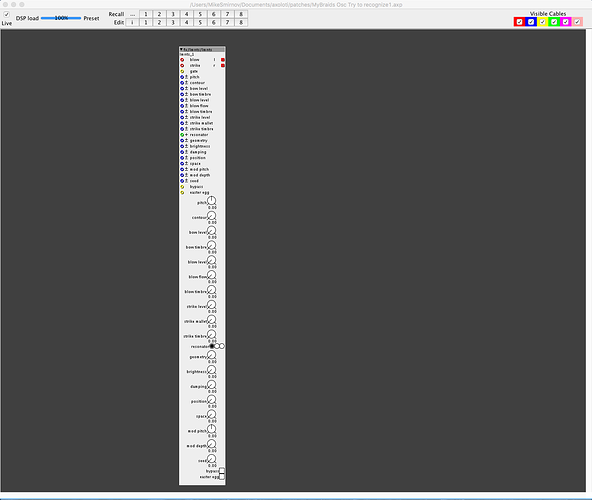lmnts (and related objects ) have now been updated (sync libraries to retrieve)
please check the help file, as these contain important info.
if you read nothing more, then summay = only use string mode 
summary
(previously the modes were incorrectly labelled!)
- "string" mode seems to work, and considered the main mode.
- "strings" mode only works when pitch and modulation pitch are kept low, this is due to cpu constaints, if I cut it down to 4 strings it works.. but this requires an axo firmware update
- "modal" mode, this seems to be blowing up often during initialisation, and whilst I can repeat, i cannot find out precisely whats going on... its not the 'panic mode' in the resonator, ... note if it blows up, you will find other modes also stop working... when it does work, its with high pitch/mod pitch and geometry.
generally, Id recommend sticking to 'string' mode (and start the patch with it in this mode, don't switch to it from 'modal'!)
dev info
as mentioned previously we are running at 48k compared to MI 32k, and also running with smaller sample buffers, this is causing quite a few issues in lmnts, since its running out of processing power at these SR.
fundamentally, this is quite an issue... downsampling is nontrivial, and doing it, also costs cpu resources.
(it should be remembered, that Elements runs on the same processor as Axoloti, and only performs one function, so its not entirely surprising... its using 100% of it, and that Axo cannot run the same code at a much higher SR)
sorry, thats about it, Ive spent quite a bit of time on this (mostly trying to decipher MI code), and Ive not really got more to spare at this point, I may take a further look when we do another release, and it moves out of the firmware. (this will make it slightly easier to debug and test, and also change) ..
it may be perhaps exposing the 'resonator' (which appears to be the core of the issue with modal mode) may allow it to be debugged easier in isolation.
anyway, hope its useful to some
Mark





